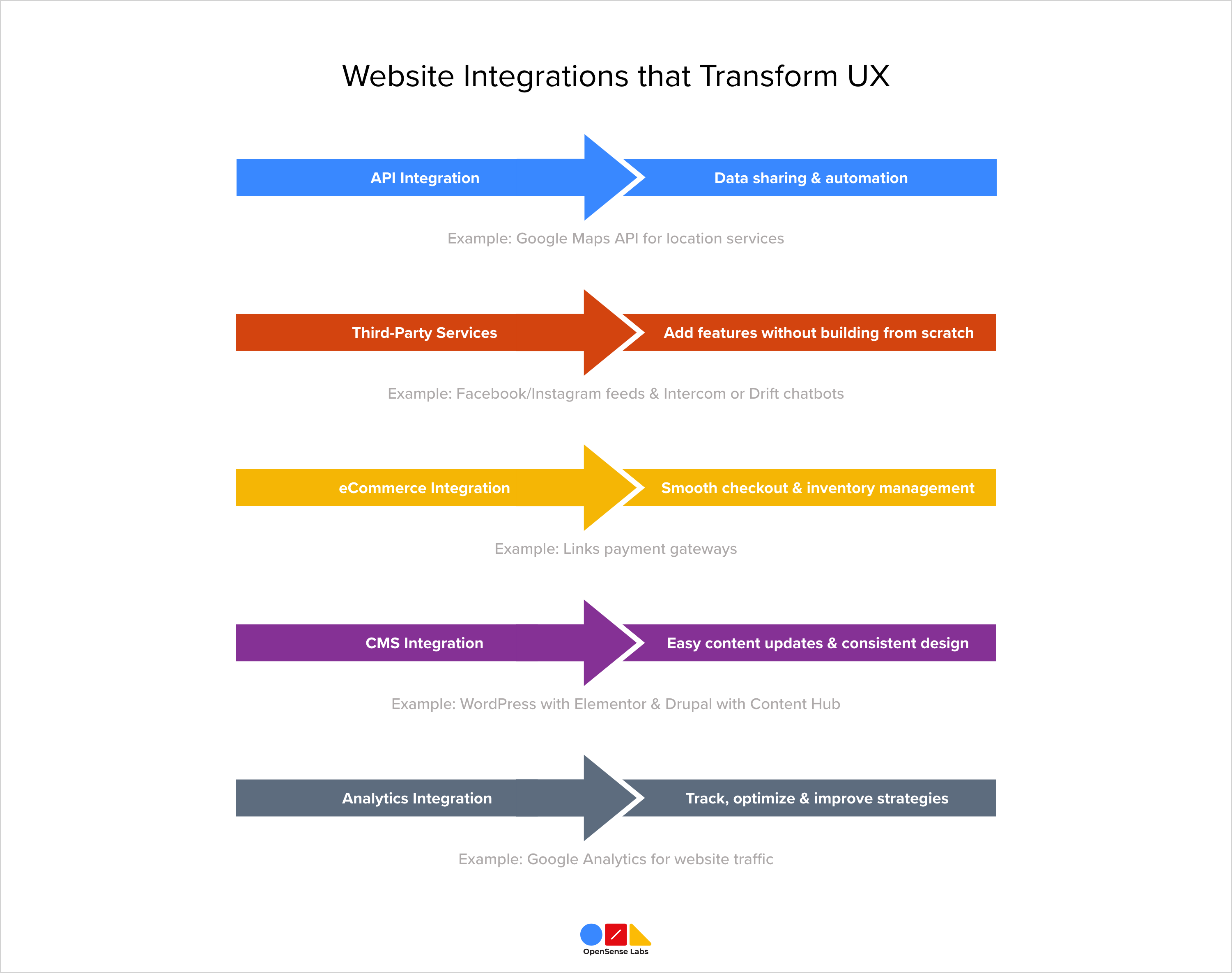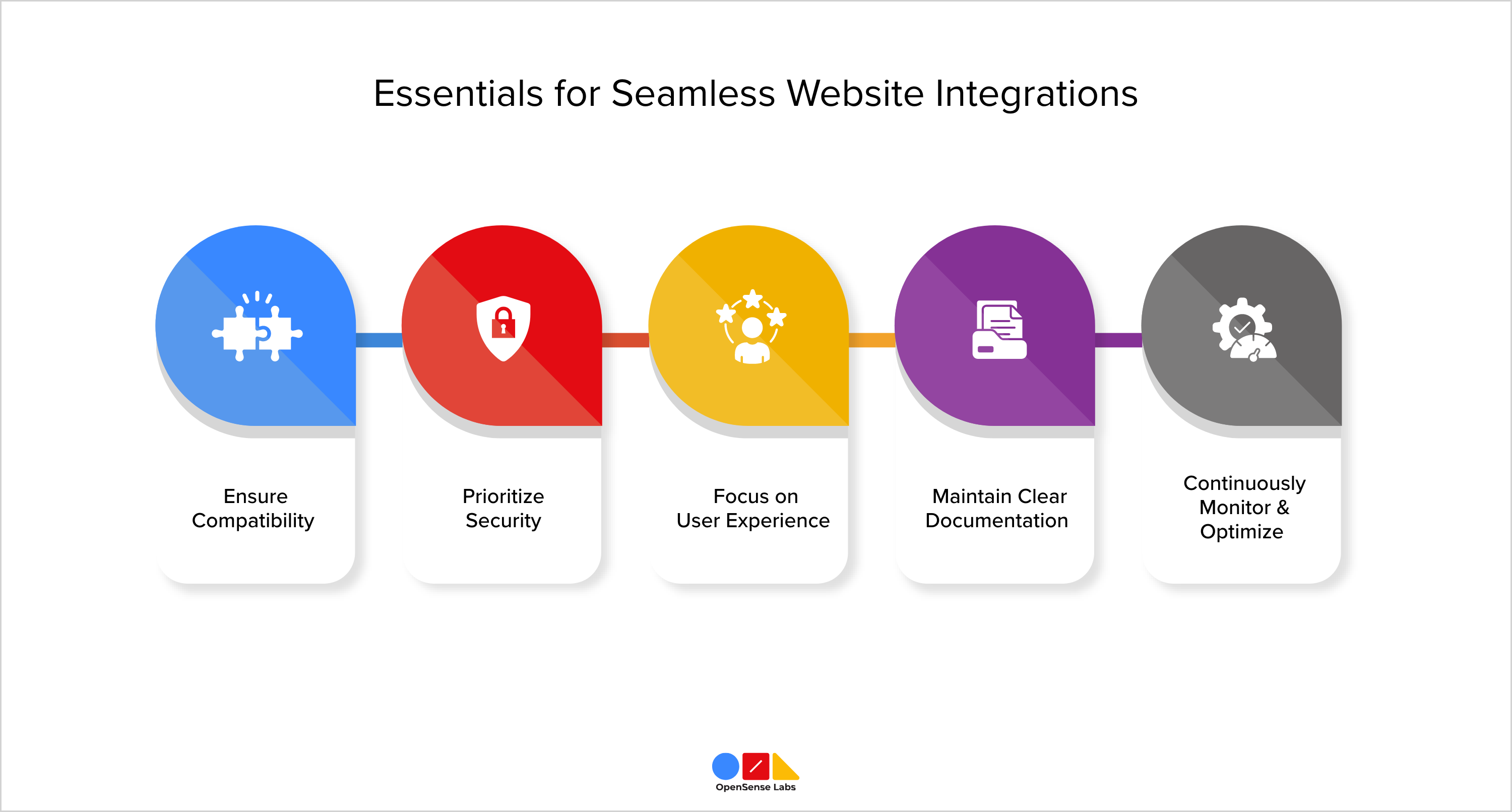UX Best Practices for Website Integrations
Website Integrations determine whether users stay engaged or abandon a site. I experienced this firsthand with a delivery app.
The other day, while ordering food online, I noticed how quickly I was moved from the restaurant’s website to a third-party delivery app. The shift was so seamless that I barely registered it, until I remembered times when the experience wasn’t so smooth. Slow redirects, clunky payment screens, or mismatched designs can make a user abandon the process altogether. That’s when you realize, whenever users are pushed into an external platform, the quality of integration defines the experience.
At its core, website integration is the process of connecting external systems, tools, or applications with your website so that information flows seamlessly between them. Whether it’s a booking system, a payment gateway, or a customer portal, integrations help businesses provide real-time updates, personalized experiences, and automated workflows.
But here’s the catch: an integration is only as strong as the user experience (UX) it delivers. A clunky checkout page, slow data transfer, or inconsistent design can frustrate users, even if the underlying tech is sound. Done right, though, integrations make the user journey feel effortless and intuitive.
Beyond usability, website integrations directly influence SEO and UX together. A well-optimized eCommerce API integration can speed up load times and streamline checkout, boosting conversions while improving search visibility. Similarly, custom API integrations allow brands to create tailored experiences that not only serve their users better but also signal quality to search engines.
In this blog, we’re going to explore the best UX practices for website integrations, covering how thoughtful design, seamless APIs, and tailored solutions can elevate user experience, strengthen SEO, and ultimately drive business growth.
If you want your website to have smooth integrations, a great UI, and an excellent UX, we can help. Explore our services to make your website more user-friendly and high-performing with Drupal.
Now, let’s get back to our understanding!
Understanding Website Integrations and UX
Website integration connects your site with external tools or platforms so they work together seamlessly. It enables your website to send and receive information, offering capabilities like real-time updates, automated workflows, and personalized user experiences.
Website integrations can be single-system (e.g., linking to a payment gateway or booking tool) or multi-system (e.g., syncing CRM, analytics, email marketing, and eCommerce platforms together). Multi-system integrations transform your website into a business hub, automating complex operations.
Types of Website Integrations
Here’s a quick overview of common website integrations and how they enhance UX:
- API Integration: Connects your site to external services, such as Google Maps or payment processors, using REST or SOAP protocols. Enables data sharing and automated functionality.
- Third-Party Services Integration: Adds features like social media feeds, chatbots, or email automation without requiring manual development from scratch.
- eCommerce Integration: Links shopping carts, payment gateways, and inventory systems for smooth transactions.
- CMS Integration: Integrates with platforms like WordPress or Drupal for content management, consistent design, and easy updates.
- Analytics and Tracking Integration: Incorporates tools like Google Analytics to monitor behavior, optimize performance, and improve marketing strategies.

Why UX Matters in Website Integrations
Website Integrations in different systems and services improve functionality and transform the entire user journey. Thoughtful website integrations bring together usability, efficiency, and consistency, making your website feel seamless and reliable.
1. Improved User Experience: Custom integrations create smooth and consistent interactions across different functions. For instance, a customer support chatbot can provide instant answers, reducing wait times and boosting satisfaction.
Navigation is another key factor; 94% of users say easy navigation is essential. By integrating features like smart search or social sharing options, businesses make interactions effortless, engaging, and aligned with user expectations.
2. Enhanced Functionality: Website integrations allow you to expand what your website can do without reinventing the wheel. Tools like live chat, payment gateways, or email marketing platforms can be added quickly through third-party solutions.
Embedding Google Maps, for example, helps users find locations instantly, improving convenience and trust.
3. Increased Efficiency: Behind the scenes, integrations streamline operations and reduce human errors. eCommerce APIs automate order fulfillment, while marketing automation saves teams from repetitive tasks.
Payment systems like PayPal, with their 90% authorization success rate, show how the right integration can not only optimize backend processes but also build trust with users at the checkout stage.
4. Improved Data Management: Website integration allows for centralized data management, enabling various systems to share and update information instantly. This advantage is particularly clear with CMS integrations that have transformed website management.
Companies such as IKEA and LINUX utilize Joomla for their website management, while brands like Coca-Cola and Ford depend on Magento. The scalable, secure, and adaptable features of CMS platforms are a key reason to trust them. Website integrations facilitate the use of CMS features and make data management easier.
ALSO CHECK OUT
- Transform Your Website with Drupal AI Module in 2025
- SDC: Integrating Storybook & Single Directory Component
- Gin Admin Theme: Replacing Claro In Drupal CMS
- Create and Integrate: CKEditor 5 Plugin in Drupal 11
UX Best Practices for Website Integrations
Adhering to best practices during website integration not only mitigates risks but also ensures that the outcome aligns with business goals and user needs. Here are the essentials:
Ensure Compatibility: Before starting any integration, it’s important to ensure that all systems can work together smoothly. This means checking that software, plugins, or APIs are updated and compatible, and confirming that data formats are consistent to prevent errors during information transfer between platforms.
API compatibility must also be thoroughly examined, including endpoints, authentication methods, and rate limits, to ensure effective communication. Conducting detailed compatibility tests like sandbox trials and stress tests can help identify problems early, avoiding expensive disruptions later on.
By focusing on compatibility from the beginning, companies can create a reliable and scalable integration that fosters long-term growth while providing a smooth user experience.
Prioritize Security: Security must be the core of every integration, as even the best features lose their worth if they endanger data or users. Using strong encryption keeps sensitive data safe during transfer, while strict access controls restrict system access to only those who are authorized.
Frequent security evaluations, like vulnerability scans and penetration tests, reveal possible weaknesses before they can be taken advantage of. It's also crucial to comply with industry regulations such as GDPR, HIPAA, or PCI DSS, based on the data type being managed, to ensure compliance and build trust.
By consistently enhancing security measures through monitoring, timely updates, and proactive risk management, companies can protect their systems and users, establishing a solid base for successful integration.
Focus on User Experience: A successful integration is truly measured by how well it blends into the user’s experience. Effective integrations should be unnoticed, like a smooth checkout, an easy booking process, or quick data transfers occurring behind the scenes.
Every step should minimize friction and lead users naturally, ensuring interactions are straightforward and enjoyable. To make this happen, companies need to perform user testing, collect genuine feedback, and continuously improve based on actual behavior. By focusing on the user in every choice, integrations enhance satisfaction and foster trust and loyalty over time.
Maintain Clear Documentation: Comprehensive documentation is crucial for maintaining transparency and manageability of integrations over time. Each step in the process must be documented, starting from initial configurations and data flow mappings to any custom code or exceptions used during implementation.
Well-organized documentation not only makes troubleshooting and future updates easier but also guarantees continuity when new developers or team members come on board. It serves as a single source of truth, minimizing reliance on individual knowledge and avoiding expensive delays. Clear and accessible records ultimately enhance the sustainability, scalability, and optimization of integrations in the long term.
Continuously Monitor & Optimize: The success of an integration doesn't stop at deployment it needs continuous attention to remain effective. Ongoing monitoring allows for tracking performance, identifying potential bottlenecks, and swiftly addressing issues before they affect the user experience.
As business requirements change, integrations must be assessed and improved to meet new objectives, technologies, and user expectations. This ongoing cycle of enhancement not only maintains system reliability and security but also guarantees that integrations stay relevant, scalable, and able to provide long-term value.

UX Principles that Strengthen Website Integrations
Beyond functionality, integrations directly shape the end-user experience. Keeping UX principles in mind ensures they add value, not friction:
- Seamless Website Interactions - Users expect to complete tasks, whether booking an appointment, making a payment, or subscribing, directly within the website. Redirecting them to external pages creates friction, increases drop-off rates, and breaks trust. By integrating these functions natively, the process feels effortless and keeps users engaged. A seamless flow not only saves time but also reinforces reliability, making the overall experience smooth and uninterrupted.
- Consistency in Design & Workflow - When multiple tools and systems are integrated into a website, they should feel like a natural extension of the site rather than disconnected add-ons. A unified design language, fonts, colors, layouts, and a consistent workflow ensure users don’t feel lost when switching between features. This reduces confusion, builds trust, and keeps the overall experience intuitive and professional.
- Performance Optimization - Speed is one of the most critical factors in user experience. Slow-loading integrations, whether it’s a custom API or an eCommerce checkout, can frustrate users and lead to higher drop-offs. By reducing latency, caching frequently used data, and streamlining backend processes, you ensure interactions remain fast, responsive, and seamless. A smooth, optimized performance not only improves conversions but also leaves users with a positive impression of your brand.
- Accessibility & Inclusivity - Every integration should be designed to be usable by all, including people with disabilities. Following accessibility standards (like WCAG) ensures features such as booking systems, payment gateways, or dashboards are easy to navigate with screen readers, keyboard shortcuts, and clear visuals. Inclusive integrations not only widen your audience reach but also demonstrate a commitment to equal access, making the experience seamless for every user.
- Mobile-First Approach - With most users browsing and shopping on mobile, integrations must be optimized for smaller screens. eCommerce APIs, payment gateways, and booking tools should load quickly, adapt to various screen sizes, and offer touch-friendly interactions. A mobile-first integration ensures users can complete tasks effortlessly, no matter what device they’re on.
- Clear Error Handling & Feedback - When something goes wrong, like a failed payment or an invalid form submission, users should receive clear, concise, and actionable messages. Integrations should guide users on how to fix issues without frustration, maintaining confidence in your website. Transparent feedback not only reduces confusion but also strengthens trust and keeps the experience smooth.
- End-User Experience Monitoring - Integrations should not be “set and forget.” Regularly tracking how users interact with features like bookings, payments, or dashboards helps identify friction points and opportunities for improvement. By analyzing real-world behavior, you can fine-tune integrations, optimize workflows, and ensure the experience remains intuitive, reliable, and aligned with user expectations.
Successful website integrations are technical achievements and experience enhancers. When businesses balance robust systems with thoughtful UX principles, they create websites that feel seamless, responsive, and trustworthy.
If you want your Drupal website to deliver seamless performance, enhanced user experiences, and reliable website integrations, explore how our expert services can help make it happen.
Now, let’s take a closer look at the use cases!
Use Cases of UX-Driven Website Integrations
Website integrations become powerful when they are designed with user experience at the center. Here are some real-world use cases where UX-driven integrations transform websites into seamless, high-performing platforms:
- eCommerce API Integration: Smooth, fast checkouts can make or break an online store. Integrating payment gateways like Stripe, PayPal, or Razorpay ensures that transactions are secure, reliable, and quick. Cart abandonment rates drop when users don’t face delays or unnecessary redirections. Likewise, integrating inventory and shipping APIs gives shoppers real-time updates, creating a transparent and stress-free purchase journey.
- Custom API Integration: Every business has unique workflows. Custom APIs allow websites to integrate tools that reflect those specific needs, like linking a booking system to a CRM or connecting a learning platform with progress-tracking dashboards. This reduces friction, avoids repetitive manual steps, and ensures that users enjoy a personalized, uninterrupted flow from one task to another.
- SaaS & Web Application Integration: For SaaS platforms, integrations are critical to simplifying complex processes. By connecting analytics tools, messaging apps, or project management software into a unified dashboard, businesses give users a single, intuitive hub to manage everything. This reduces cognitive load, improves adoption, and creates a sense of control, hallmarks of great UX.
Whether it’s faster checkouts, tailored workflows, or unified dashboards, UX-driven integrations focus on making digital interactions effortless, trustworthy, and enjoyable.
ALSO CHECK OUT
- Free Learning Content Management System: Best 10 List For 2025
- Ethical AI Chatbot: Implementing the RAIL Framework at OSL
- Agentic AI Dynamics: Future of Data Retrieval
- Headless CMS vs Traditional CMS: What's The Difference?
Key Takeaways
- Website integration involves linking outside systems, tools, or applications to your website, allowing for smooth information exchange between them.
- An effectively optimized eCommerce API integration can enhance load speeds and simplify the checkout process, increasing conversions and enhancing search visibility.
- Thoughtful website integrations streamline user journeys, reduce friction, and make digital experiences intuitive, consistent, and engaging.
- Integrating APIs, eCommerce, CMS, and analytics enhances functionality, efficiency, and real-time data management for seamless websites.
- Secure, accessible, and mobile-optimized integrations ensure reliable, inclusive, and smooth interactions across all devices and platforms.
Subscribe
Related Blogs
How design thinking acts as a problem solving strategy?

The concept of design thinking is gaining popularity these days since people across different industries are using it as a…
10 major challenges that come across during an agile transformation

It’s no longer a mystery that agile was created as a response to the various concerns that the traditional waterfall…
Design as a team: An extensive guide to cross-functional collaboration

Cross-functional collaboration plays a vital role in accelerating the delivery of better results for consumers. It promotes…




